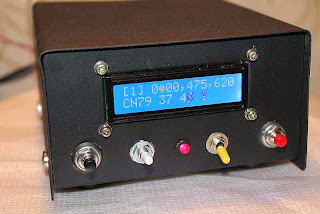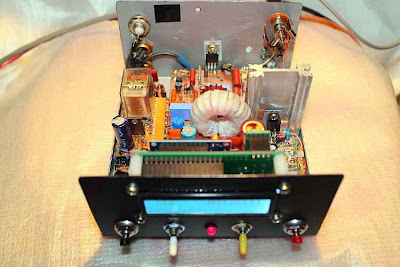 Arrival of the Radio Communication Handbook
Arrival of the Radio Communication Handbook
http://www.rsgbshop.org/acatalog/Online_Catalogue_Technical_6.html#a1426
Certainly this has come a long way since I started in the hobby with the 5th Ed back in 1982.
I have always seemed to have received it for a present everytime it has been revised over the years. This year was a rare exception, I was able to use my £5 members discount voucher towards the cost of purchasing it myself, for an early Winter read.
The fundamental wheels of electronics is always covered very well, and seems much improved. With Chapters on the Principles, Passive Components, Semiconductors & Valves, The Building Blocks Oscillators, Mixers and Amps etc. Good information for those starting out on the radio road, and the novice who is underway, this is very much a must! Even the experienced like myself who would like to refer back to the basics over time if not sure, will find it contains all the invaluable stuff one is likely to ever need!
Like always, it covers HF Receivers, Transmitters, Propagation, Transmission lines, Antenna basics along with Practical HF, VHF/UHF Antennas, and Microwave RX & TX, enough information to get you clued up for any Amateur test.
New content I have noticed in this edition is the Eamon Skelton EI9GQ Transceiver project, which featured in Radcom sometime ago. Here it is condensed into one chapter in abridged format, and is well worth the buy of the book alone! If you are interested in building a QRP transceiver, or something decent and uncomplicated that will work, by understanding the way he lays it all out in a simple format from stage to stage, this is certainly the section that one needs to read.
Also an excellent VLF chapter that also covers the new 472KHz allocation, along with a good Data & Computers in the shack section, including a small mention of the Raspberry PI & Arduino. Along with EMC & Power supplies, Morse Code, Test equipment, Construction & Workshop practice.
There is so much packed into its 864 pages and I have only touched on a small part. But it is a great reference and addition to the Shack.
This is the book that sets the benchmark and may be the only one you ever require!
Steve, G1KQH, is a regular contributor to AmateurRadio.com and writes from England. Contact him at [email protected].
 For any readers from the greater NYC region
For any readers from the greater NYC region
Gordon "Gordo" West, WB6NOA, author, lecturer and creator of many Ham Radio study guides and related products will be in town this weekend and next week.
He will be at KJI Electronics this weekend, where he will be holding Technician and General Class license review classes followed by an exam session. Advanced registration is required as space is limited. Go to www.kjielectronics.com for more information.
He is the scheduled guest speaker at the Suffolk County Radio Club Meeting on Tuesday, November 18 at 7:00 PM (Time change! From 8:00 PM to 7:00 PM!). Guests are always welcome so feel free to attend:
Grace Lutheran Church
240 Mastic Road
Mastic Beach, NY
For more information, the club website is: http://suffolkcountyradioclub.net/
He will also be at the Great South Bay Amateur Radio Club on Thursday November 20th at 8:00 PM:
Babylon Town Hall
220 East Sunrise Highway
Lindenhurst, NY.
Talk-in on the W2GSB repeater 146.685 MHz 110.9 HZ PL For more info go to the club website: http://www.gsbarc.org/
This information appears too good not to share - so I re-posted.
72 de Larry W2LJ
QRP - When you care to send the very least!
Larry Makoski, W2LJ, is a regular contributor to AmateurRadio.com and writes from New Jersey, USA. Contact him at [email protected].
 “CQ BR” – The Bug Roundup!
“CQ BR” – The Bug Roundup!
Sponsoring the event is the Samuel F. Morse Amateur Radio Club (W6SFM) of Sacramento, CA. Detailed information may be found at their website, located here.
The club page describes the event as :
"a special time to bring bug operators together on the air. In the same spirit as ARRL's Straight Key Night, participants are encouraged to make simple, conversational, “chewing-the-fat” QSOs using their bug type key. This is an opportunity to exercise, share and exhibit your personalized fist. This is NOT a contest. Call "CQ BR" so folks know you are a Bug Roundup Participant."
You may have guessed by now that I love CW and always have, since learning the 'code' as an eleven-year old in Scouts! Our Scoutmaster had procured several sets of beautiful boxed Aldis signalling lamps, the same as shown below:
 |
| Image Courtesy: http://www.museumoftechnology.org.uk |
Our leader worked in the Marine Building, the tallest building at the time, in downtown Vancouver.
 |
| Marine Building circa 1947. Courtesy: http://searcharchives.vancouver.ca/ |
It nice to see events like this and the ARRL's "Straight Key Night" along with clubs like the, "SKCC" , "FISTS", "FOC" and "The CW Operators' Club", all doing their best to keep CW alive. Hopefully you will have some time to play in the 'BR' this weekend.
Steve McDonald, VE7SL, is a regular contributor to AmateurRadio.com and writes from British Columbia, Canada. Contact him at [email protected].
 QRP radios
QRP radios
I continue to be surprised by how few affordable QRP radios are on the market. The FT817ND continues to be the favourite, but recent exchange rate changes have not been matched by decent falls in the UK retail prices. I think we are still being ripped off by dealers in the UK. The IC703 is no longer made and the KX3 from Elecraft is very expensive over here. There are a few lower cost Chinese HF radios appearing. Overall, there remains little choice in QRP transceivers at sensible prices. I am sure the KX3 is a very good radio but for the same price I can buy 2 FT817 transceivers, and these are all mode and to 70cms.
A multi-band, all mode, 5-10W radio would be a killer in this age where people take lots of holidays and are on the move frequently. I still fail to understand why the big Japanese manufacturerers have not got a raft of low cost units on the market. It seems a gold mine opportunity is being wasted. Maybe I have misread the market?
I know if there was a new, attractively featured, QRP transceiver on the market now at a sensible price I’d be in the line to buy. I am sure very many others would be too.
Roger Lapthorn, G3XBM, is a regular contributor to AmateurRadio.com and writes from Cambridge, England.
 My Latest Contraption, a QRP portable, all in one, seat & table, etc!
My Latest Contraption, a QRP portable, all in one, seat & table, etc!
I added a bungee cord on each end to prevent damage from the radio accidentally falling off the table.
 The cord does not touch the buttons.
The cord does not touch the buttons.
View from the back
All in one, QRP seat, table, umbrella and antenna anchor! The bottle on the table is bug spray! LOL
The table is a cutting board attached to the existing shelf.
The cutting board is bigger than the existing shelf, so I have more room for logging and a sturdy place to attach the antenna!
A bungee cord takes up the slack from the antenna in the wind. In a real world test, I found that one radial is all I need.
I tried an experiment, adding two, then four radials. There was no detectable change in signal level by ear on or the S meter.
One radial did the trick, and 4 radials didn’t improve the signal at all.
Note the guy ropes. This is to hold the chair in place. The golf umbrella is stuffed into a piece of PVC pipe.
The PVC pipe is tied to the chair with cable ties.
Wind and the antenna pulling on the table would easily turn the chair over.
Satisfaction! I can’t wait for the next ham radio outing with my QRP buddies.
Ernest Gregoire, AA1IK, is a regular contributor to AmateurRadio.com and writes from Florida, USA. Contact him at [email protected].
 Review session
Review session
After each exam was completed, we went over the tests together as a group. It appears that on both exams, no one got more than six answers incorrect. Since a passing grade allows for nine incorrect answers, it would appear that we are looking at a bunch of new Amateur Radio ops as of next Tuesday night.
To break things up a bit, we showed an Amateur Radio video in between the two exams. In all, I thought last night's session was exceptional. Our class members have proven to be eager, bright, inquisitive, and open to what we have been presenting to them.
It has been an honor and a privilege to work with them, as well as with my two fellow instructors, Marv K2VHW and Drew W2OU. These two are amazing Amateur Radio ops and have an amazing amount of experience behind them. The fact that Marv K2VHW is a retired broadcast engineer from WABC with a couple of Emmy Awards under his belt doesn't hurt, either!
I am looking forward to next week, and I just sent the group a final e-mail, detailing what to bring next week and basically telling how proud of them that we are. It's great to be able to help increase the ranks of Amateur Radio. I also reminded them to relax. This is supposed to be fun, and besides, in the scheme of things, it's not like we're looking to cure cancer or end world hnger.
Oh, and by the way, I did work John K4BAI in Georgia, one of the 40 Meter Foxes last night. I tried to work Kevin W9CF in Arizona, but I think the good props between NJ and AZ were over by the time I got home and wolfed down dinner. I see from his Fox log that Kevin worked some NJ stations, but that was while I was still in class. By the time I was trying to work him, he was 229 - 339 at best and I just couldn't make myself be heard. There is nothing more frustrating than calling a station who is sending a CQ in the clear, only to have them resume calling CQ after you send your call!
72 de Larry W2LJ
QRP - When you care to send the very least!
Larry Makoski, W2LJ, is a regular contributor to AmateurRadio.com and writes from New Jersey, USA. Contact him at [email protected].
 A Fine “U3” Package For 630m
A Fine “U3” Package For 630m
The "U3" is the Ultimate3 QRSS/WSPR Transmitter Kit produced by Hans Summers (GØUPL) and is fast becoming a popular and inexpensive workhorse among WSPR fans. A short description from GØUPL's website indicates that the "U3" is:
"the third version in the "Ultimate" QRSS/WSPR kit trilogy. It can produce QRSS, Hell, WSPR, Opera and PI4 slow-signal modes anywhere from audio to 10m and above. Plug-in LPF filters are available for all 12 HF/MF/LF bands."
Jack has tailored his version for our new (to Canadian amateurs) 630m band but has also added a versatile MOSFET linear amplifier of his own design that runs on 12VDC. Using an inexpensive IRF540 switching FET, Jack can run up to 30W of output on 630m but normally runs at the 5-10W level on 475 kHz. Most of Jack's homebrew gear looks as if it just came off the Hewlett-Packard assembly line and his latest project is no exception.
 |
| All images courtesy of VA7JX |
Using mainly the WSPR (Weak Signal Propagation Reporter) mode, Jack and many others, have found that 630m offers some amazing propagation, considering the low ERP levels imposed by the backyard-sized antenna efficiencies on this band. Using an inverted "L", resonated for 630m, his 5W signal has been spotted by the following stations in the past few days:
WH2XCR (Hawaii) at 4258 km.
WG2XJM, 3552 km, Shawnee, OK
WH2XHY, 2822 km, Fitchborg Wi.
WG2XXM, 2789 km, Wichita Kansas.
N6KOG, 1390 km, Tracy Ca.
KK6EEW, 1284 km, Healdsburg Ca.
WE2XPQ, 1172 km, Alaska
W7LW, 983 km, Kuna, ID
W7MY, 605 km, Richland WA.
WH2XGP, 504 km, Quincy, WA
VA7JX is one of the three west coast Canadian stations that have transmit-capability on 630m, the two others being myself and VE7BDQ (John). John can be found most nights on the 475kHz WSPR mode as well, running the legal limit of 5W EIRP into a small inverted "L" as well. John has also enjoyed good success on WSPR, having been spotted regularly on the east coast and more recently, in Hawaii. For exact frequencies of both stations, check the WSPRNet Activity page for the latest real-time information.
Although WSPR works well as a propagation indicator....and it seems that there is plenty of nice propagation on 630m....it does not allow two stations to actually QSO each other. Our new band really needs more Canadian stations to spark activity and get things rolling! Ideally, it would be nice to call CQ on the band, with a realistic hope of getting a reply.
With three VE7's now 'all-ears', nightly activity from VE6, VE5, VE4 and VE3 would be an exciting prospect and would really liven-up what seems to be a very prop-friendly part of the spectrum...who'd a thought it? It seems that amateurs are now re-discovering what the maritime operators have known for decades!
If any of us can help you with getting on-the-air, please do not hesitate to ask....and, if you are presently building or testing, you can look for your signal on the VA7JX 630m screen grabber....a real-time view of the band from VE7 land and available any time, by chance or by request, from VA7JX.
Steve McDonald, VE7SL, is a regular contributor to AmateurRadio.com and writes from British Columbia, Canada. Contact him at [email protected].

























